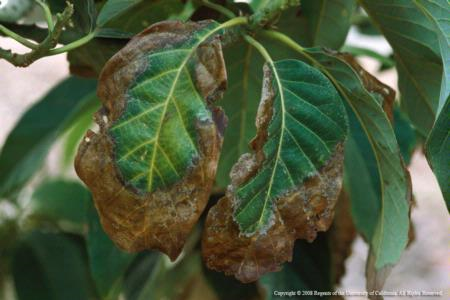- Author: Ben Faber
The talk of drought and water restrictions in the State has created a time for serious decisions. What can be done with avocado citrus trees that have been invested with time and money when there are allocations of water? Although this article is addressed to subtropicals specifically, the guidelines are generally applicable to all fruit trees.
Irrigation systems and scheduling
One of the surest, although not necessarily the cheapest, ways of managing with a decreased amount of water is to improve its application and scheduling. Insure that equipment is working properly, that nozzles are not plugged or worn, that pressures in the irrigation blocks are uniform, that leaks are repaired, and that no runoff or deep percolation are occurring. Many Resource Conservation Districts have Mobile Labs that can help make a system evaluation.
In the Ventura area, oranges use about 30 inches of water per year, however , the monthly amount varies with weather. Applying water in the amounts and at times for optimum production can be improved by using tensiometers. A gauge reading near 40 centibars has been recommended for the one foot tensiometer. The three foot tensiometer can be used to determine the amount of moisture stored in the lower horizon and to determine whether the irrigation was effective, whether the irrigation water infiltrated down to that depth.
Whatever reading is used there is no substitute for observation of the trees themselves and the soil.. Use a soil sampler or shovel to verify the depth of water applied. If time clocks are being used, turn them off or at least adjust them frequently enough to accommodate changing weather patterns. Use of CIMIS weather data can aid in correcting schedules to changing weather.
If water applications need to be curtailed, there will be a decline in yield and fruit size. Applying something less than about 75% of tree requirement will give reduced yields not only for this year, but will lead to dieback and low yields for 3 -4 years after. Abandoning the trees altogether will also yield little or no crop and dieback, but the trees will often return to normal yields in 3 - 5 years. If little water is available, it may be best for commercial operators to reduce the number of trees irrigated to those that can receive 85% of their water requirement and abandon the rest, hoping for more water in future years.
Cultural practices
Since it is the leaves that are the site of water loss , the best way to reduce water loss is to reduce the amount of leaves present. This is the ideal time to thin an orchard, get rid of those trees that are shading each other and reducing the per tree yield of fruit. This is a good time to topwork trees to better varieties, since the smaller trees will use less water. A good weed management program will reduce competition for water, and mulching the wetted area of the sprinkler will reduce evaporative loss from the soil surface. Once the leaf area is reduced, it is necessary to adjust the irrigations to reflect the decreased need for water.
This is an opportunity to identify the least productive trees in an orchard and cut of water to them. Trees with root rot or frost damage; trees growing on limy/iron chlorosis sites. Trees growing on ridges that receive the full force of the wind and have a lower yield per gallon of water should be considered first. Trees growing on the perimeter of an orchard also will transpire more water for a given amount of fruit. If all trees in the orchard look good, then these perimeter trees should be targets for saving water. If production records have been kept for different blocks of trees, it might be possible to identify low yielding areas that could be sacrificed.
This is an opportunity , as well. Many growers have kept poor producing parts of groves going because it is an emotional issue to cut up a tree. Seize the day and take advantage of the situation.
For more, check out the powerpoint




